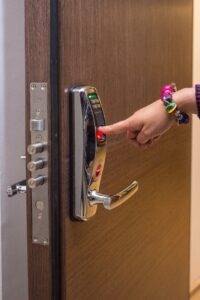Biometrics refers to the measurement and statistical analysis of people’s unique physical and behavioural characteristics. These characteristics are used to identify and verify individuals. Biometric systems are designed to recognise and authenticate people based on traits that are difficult to forge or replicate.
There are two main types of biometric characteristics. The first is the Physiological Biometrics, these are physical traits unique to an individual’s body. Common physiological biometrics include:
- Fingerprints: The patterns of ridges and valleys on the fingertips.
- Facial Recognition: Analyzing facial features and patterns.
- Iris Recognition: Examining the unique patterns in the coloured part of the eye (iris).
- Retina Scans: Mapping the blood vessel pattern at the back of the eye.

 The second is behavioral biometrics, which are related to patterns of behaviour or actions. Examples include:
The second is behavioral biometrics, which are related to patterns of behaviour or actions. Examples include:
- Voice Recognition: Analyzing the unique vocal characteristics.
- Keystroke Dynamics: Examining typing patterns and speed.
- Signature Dynamics: Analyzing the way an individual signs their name.
Biometric systems capture these characteristics and convert them into a digital format for comparison and authentication. The idea is that each person has unique and consistent traits, making biometrics a reliable identification method. Biometric technology is commonly used in various applications, including access control systems, security, and personal devices like smartphones.
The discourse on biometric locks effectively underscores their heightened security features, leveraging unique physical or behavioural attributes. Drawing a parallel with the widely recognised iPhone’s Face ID adds a relatable dimension, and the anticipation of ongoing refinement aligns seamlessly with the dynamic nature of security measures.
The emphasis on keyless entry systems, particularly in commercial environments, is well articulated. The benefits of convenience,  programmability, and the ability to record data for security audits are delineated. The acknowledgement of software solutions streamlining locksmith operations is noteworthy. The integration of technology not only into locks but also in managing locksmith businesses introduces a layer of operational efficiency.
programmability, and the ability to record data for security audits are delineated. The acknowledgement of software solutions streamlining locksmith operations is noteworthy. The integration of technology not only into locks but also in managing locksmith businesses introduces a layer of operational efficiency.
 The exploration of 3D printing’s potential in the locksmith industry, specifically for key production, showcases forward thinking. The concept of generating keys on demand from a photograph or scan reflects the industry’s adaptation to contemporary manufacturing techniques. The recognition of cybersecurity challenges in the digital age is critical. The evolving responsibility for locksmiths to safeguard against cyber threats highlights the industry’s need for vigilance and adaptation in response to a changing landscape.
The exploration of 3D printing’s potential in the locksmith industry, specifically for key production, showcases forward thinking. The concept of generating keys on demand from a photograph or scan reflects the industry’s adaptation to contemporary manufacturing techniques. The recognition of cybersecurity challenges in the digital age is critical. The evolving responsibility for locksmiths to safeguard against cyber threats highlights the industry’s need for vigilance and adaptation in response to a changing landscape.
The acknowledgement of the continuous need for training and education is essential. Highlighting topics such as electronic access control, biometric systems, and cybersecurity as components of professional development underscores the industry’s commitment to staying pertinent and competitive. These remarks effectively encapsulate the transformative journey of the locksmith industry, emphasising its evolution and adaptation to modern technology. The candid recognition of challenges, particularly in maintaining security, adds a pragmatic touch to the overall optimism about the industry’s future.
Biometric security systems are already used for access control in buildings, offices, and secure facilities. Fingerprint, iris, or facial recognition systems are employed to ensure authorised entry while home use systems are slowly starting to appear in residential dwellings around the UK.

I’ve become a regular on this brilliant website, they provide wonderful content for users. The site owner works hard to inform the community. I’m a big fan and hope they continue their great service!